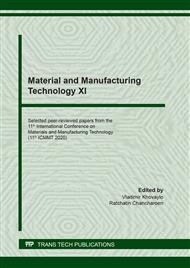p.61
p.67
p.73
p.83
p.90
p.96
p.102
p.108
p.114
Welding Shape Control of Cross Member Backbone Assembly by Automatic Gas Metal Arc Yaskawa-MA1440 Type
Abstract:
In order to prevent distortion caused by heat which affects the material deformation, the properties controlled are required. The properties changes and the placement of the mounting position will effect the weld strength that causes cracks and broken joints, therefore it affects the safety of machine construction. Thus, the objective of this paper is to control the shape of cross member backbone assembly by gas metal arc welding (GMAW). The welding is produced by an automatic robot Yaskawa-MA1440 type. In order to obtain the good quality of the result, the welding shape is controlled by a parameters combination of voltage, current, and speed. Yaskawa-MA1440 type is used as the automatic welding machine. The main material used is cold rolled steel coil sheet MJSC270D-OD with a thickness of 1.2 mm. In addition, to control the welding shape, the specified shape design standard is followed include travel speed, gas flow, welding direction, torch tip distance to the workpiece, torch angle and welding angle. The results of visual and dimensional were also examined in this research. Furthermore, the macrostructure i.e. leg length, fusion penetration, throat thickness have been analyzed and confirmed based on the standards used in the auto body vehicle part company. The appropriate parameters for the finest welding shape are defined at the horizontal position using an electric current of 120 A and the welding voltage of 18 V (± 1 V). Thus, the measurement control of macrostructure is defined as reference parameters for mass production of cross member backbone assembly.
Info:
Periodical:
Pages:
90-95
Citation:
Online since:
February 2021
Authors:
Keywords:
Price:
Сopyright:
© 2021 Trans Tech Publications Ltd. All Rights Reserved
Share:
Citation:


